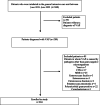Characteristics of ventilator-associated pneumonia due to Gram-negative bacteria in the intensive care unit: A single-center experience
- PMID: 40587686
- PMCID: PMC12212802
- DOI: 10.1097/MD.0000000000042946
Characteristics of ventilator-associated pneumonia due to Gram-negative bacteria in the intensive care unit: A single-center experience
Abstract
Ventilator-associated pneumonia (VAP) is one of the most common and serious infections in hospitalized patients. VAP is associated with worse outcomes and significant morbidity and mortality worldwide. Our primary goal in this study was to identify the VAP pathogen with its distribution characteristics, clarify risk factors, prognosis, and outcomes, and help reduce associated morbidity and mortality. This retrospective observational study was conducted between June 2019 and June 2022 in 3 general intensive care units of a training and research hospital. Data on demographic, clinical and laboratory parameters were collected retrospectively from medical cards and electronic records. A total of 204 patients were diagnosed with VAP caused by Gram-negative microorganisms. Chronic renal failure (RF) and neurological diseases were significantly associated with mortality (P = .01, P = .023). The duration of mechanical ventilation before VAP and the duration of mechanical ventilation were significantly longer in survivors compared to non-survivors. The number of patients with early VAP was significantly higher, and the days of VAP were shorter in the non-survivors compared to the survivors (P = .006, P = .016). The number of VAP episodes (P = .0001), the presence of RF, acute respiratory distress syndrome, bacteremia, and sepsis before VAP (<48 hours) were associated with mortality. Intensive care unit and the length of hospital stay were significantly shorter in non-survivors than in survivors (P = .0003, P = .0001). Administration of monotherapy, inadequate empirical antibiotic therapy, inadequate antibiotic therapy (P = .004, P = .002, and P = .0006), persistence of the pathogen (P = .0001), C-reactive protein and procalcitonin levels (P = .002, P = .041) were associated with mortality. The presence of neurological diseases and RF was associated with a greater likelihood of mortality in patients with VAP. As risk factors, early-onset VAP, presence of RF-acute respiratory distress syndrome-bacteremia-sepsis 48 hours before VAP, organ failure, need for hemodialysis, shock and the persistence of the pathogen increased the risk of mortality.
Keywords: Gram-negative microorganisms; mortality; multidrug-resistant pathogens; prognosis; ventilator-associated pneumonia.
Copyright © 2025 the Author(s). Published by Wolters Kluwer Health, Inc.
Conflict of interest statement
The authors have no funding and conflicts of interest to disclose.
Figures


Similar articles
-
Antibiotics for ventilator-associated pneumonia.Cochrane Database Syst Rev. 2016 Oct 20;10(10):CD004267. doi: 10.1002/14651858.CD004267.pub4. Cochrane Database Syst Rev. 2016. PMID: 27763732 Free PMC article.
-
Oral hygiene care for critically ill patients to prevent ventilator-associated pneumonia.Cochrane Database Syst Rev. 2016 Oct 25;10(10):CD008367. doi: 10.1002/14651858.CD008367.pub3. Cochrane Database Syst Rev. 2016. Update in: Cochrane Database Syst Rev. 2020 Dec 24;12:CD008367. doi: 10.1002/14651858.CD008367.pub4. PMID: 27778318 Free PMC article. Updated.
-
Ventilator associated pneumonia in COVID-19 patients: A retrospective cohort study.Tuberk Toraks. 2023 Mar;71(1):41-47. doi: 10.5578/tt.20239906. Tuberk Toraks. 2023. PMID: 36912408 Free PMC article.
-
Semi-recumbent position versus supine position for the prevention of ventilator-associated pneumonia in adults requiring mechanical ventilation.Cochrane Database Syst Rev. 2016 Jan 8;2016(1):CD009946. doi: 10.1002/14651858.CD009946.pub2. Cochrane Database Syst Rev. 2016. PMID: 26743945 Free PMC article.
-
Incidence, microbiology, and mortality of ventilation-associated pneumonia in a large Italian cohort of critically ill patients: results from the PROSAFE project.Clin Microbiol Infect. 2025 Sep;31(9):1491-1499. doi: 10.1016/j.cmi.2025.05.026. Epub 2025 May 27. Clin Microbiol Infect. 2025. PMID: 40441355
References
-
- Boev C, Kiss E. Hospital-acquired infections: current trends and prevention. Crit Care Nurs Clin North Am. 2017;29:51–65. - PubMed
-
- Torres A, Niederman MS, Chastre J, et al. International ERS/ESICM/ESCMID/ALAT guidelines for the management of hospital-acquired pneumonia and ventilator-associated pneumonia: guidelines for the management of hospital-acquired pneumonia (HAP)/ventilator-associated pneumonia (VAP) of the European Respiratory Society (ERS), European Society of Intensive Care Medicine (ESICM), European Society of Clinical Microbiology and Infectious Diseases (ESCMID) and Asociación Latinoamericana del Tórax (ALAT). Eur Respir J. 2017;50:1700582. - PubMed
-
- American Thoracic SocietyInfectious Diseases Society of America. Guidelines for the management of adults with hospital-acquired, ventilator-associated, and healthcare-associated pneumonia. Am J Respir Crit Care Med. 2005;171:388–416. - PubMed
Publication types
MeSH terms
LinkOut - more resources
Full Text Sources
Research Materials

